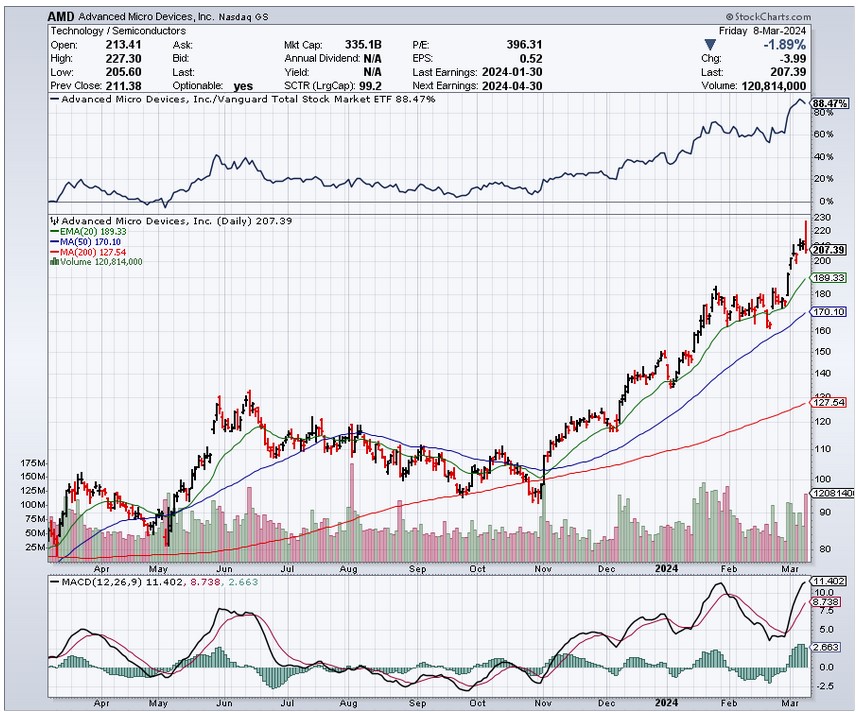(AMD), (NVDA), (MSFT), (META)
Let me lay it out straight – the AI game is getting hotter by the minute, and while NVIDIA (NVDA) has been hogging the limelight with its fancy AI chips, Advanced Micro Devices (AMD) is quietly sneaking up with a strategy that might just give it a leg up. It's like the tortoise and the hare, but with an AI twist.
AMD has this new AI silicon, the MI300X, and while it's chalking up sales, the real cherry on top is its ROCm software platform. After all, it's not just about having the shiniest chip on the block; it’s the brains behind it that count.
Now, I've heard some folks whispering that AMD might be lagging in this race, especially when you stack it up against Nvidia’s CUDA software stronghold.
But, AMD’s last earnings call threw a curveball that’s got me tipping my hat to them. They’re not just in the game; they’re looking to shake things up with their "Instinct" AI accelerators and their software game.
Here’s why AMD might just be the dark horse in the AI derby.
First, it might be helpful to think of Nvidia and AMD’s head-to-head as the battle of the software: closed vs open source.
Think of Nvidia’s CUDA as the Fort Knox of software – closed, secure, and the gold standard for optimizing GPU performance. It’s been around the block, setting the pace since 2006.
Then, suddenly, here comes AMD, swaggering in with its ROCm software platform, and flipping the script by making it open source. They’re basically throwing open the doors and inviting every coder in the land to tinker with it.
This is a bold move from AMD, with the company aiming to democratize the space and maybe, just maybe, outmaneuver Nvidia’s grip on the market.
And what’s AMD’s ace? They’re betting big on avoiding that dreaded "vendor lock-in" – you know, when you’re so tied to one company’s tech that you can't so much as sneeze without asking their permission.
By making ROCm open source, AMD is playing the long game, aiming to win over those who value flexibility and hate being backed into a corner.
Now, let’s take a look at how generative AI is involved in AMD’s open-source gambit.
Reviewing their strategy, it’s clear that AMD’s not just throwing darts in the dark here. They’ve got their sights set on generative AI, and their open-source ROCm is the weapon of choice.
It seems as if AMD is building a playground and inviting all the cool kids (developers) to come play.
In fact, AMD’s vision has been manifested by Microsoft (MSFT) getting GPT-4 up and running on MI300X faster than you can say "AI revolution."
It also has partnerships with Hugging Face, one of the fastest-growing machine learning org, to get a slew of AI models running smoothly on AMD GPUs.
Even Meta’s (META) throwing its weight behind AMD’s MI300X.
The message is clear: AMD’s not just selling chips; they’re building ecosystems.
But before you start counting your chickens, remember that the tech world is fickle, and AMD’s strategy, while slick, isn’t without its hurdles.
NVIDIA’s not sitting on its laurels; its CUDA platform is a behemoth, with a developer community that’s growing faster than a weed in the spring.
And let's not forget the DIY crowd – big data center operators like Microsoft Azure who prefer rolling out their own chips and software.
AMD’s got its work cut out, but if they play their cards right, they could carve out a nice piece of the AI pie for themselves.
In the cutthroat tech world, AMD’s making a play that’s as bold as it is smart. By betting on open source and targeting generative AI, they’re not just aiming to catch up; they’re looking to set the pace.
Sure, the road’s going to be bumpy, and NVIDIA’s not exactly going to roll out the red carpet for them, but AMD’s strategy has got a certain flair that’s hard to ignore. So, here’s my two cents: Keep an eye on AMD. They might just surprise us all.


